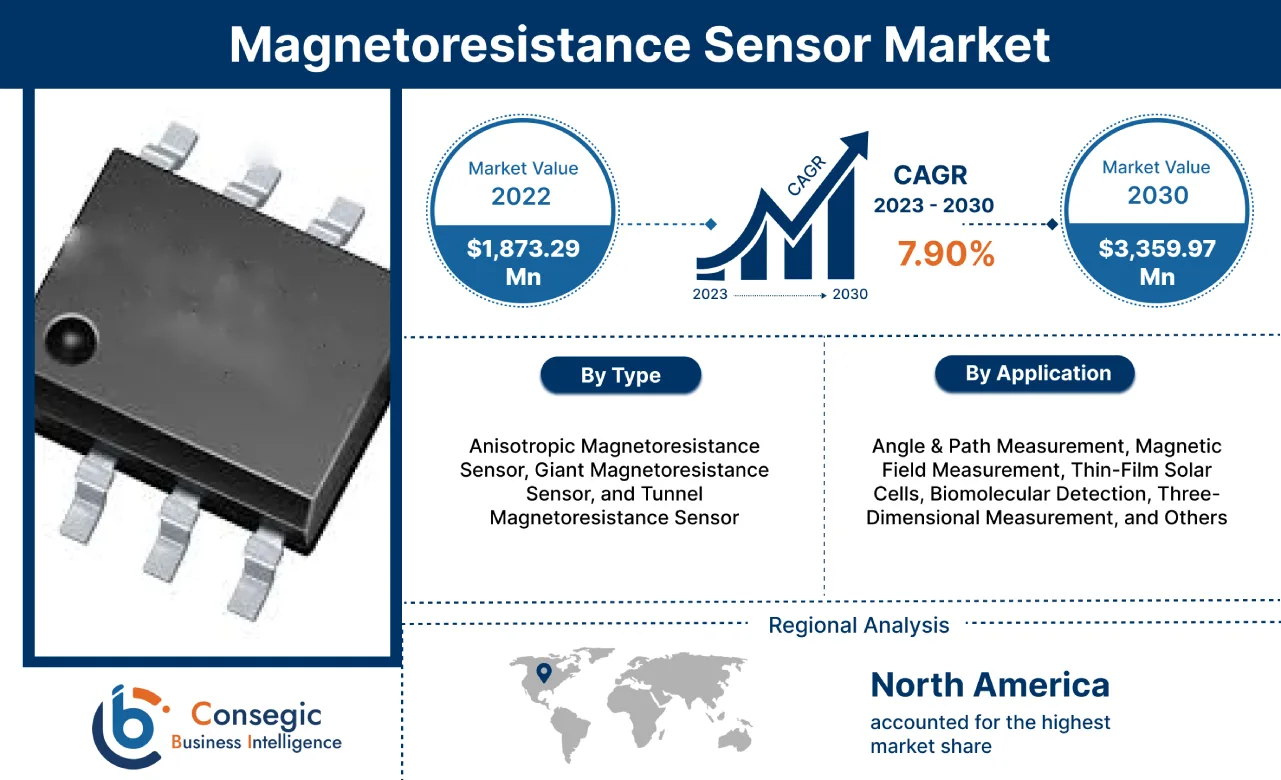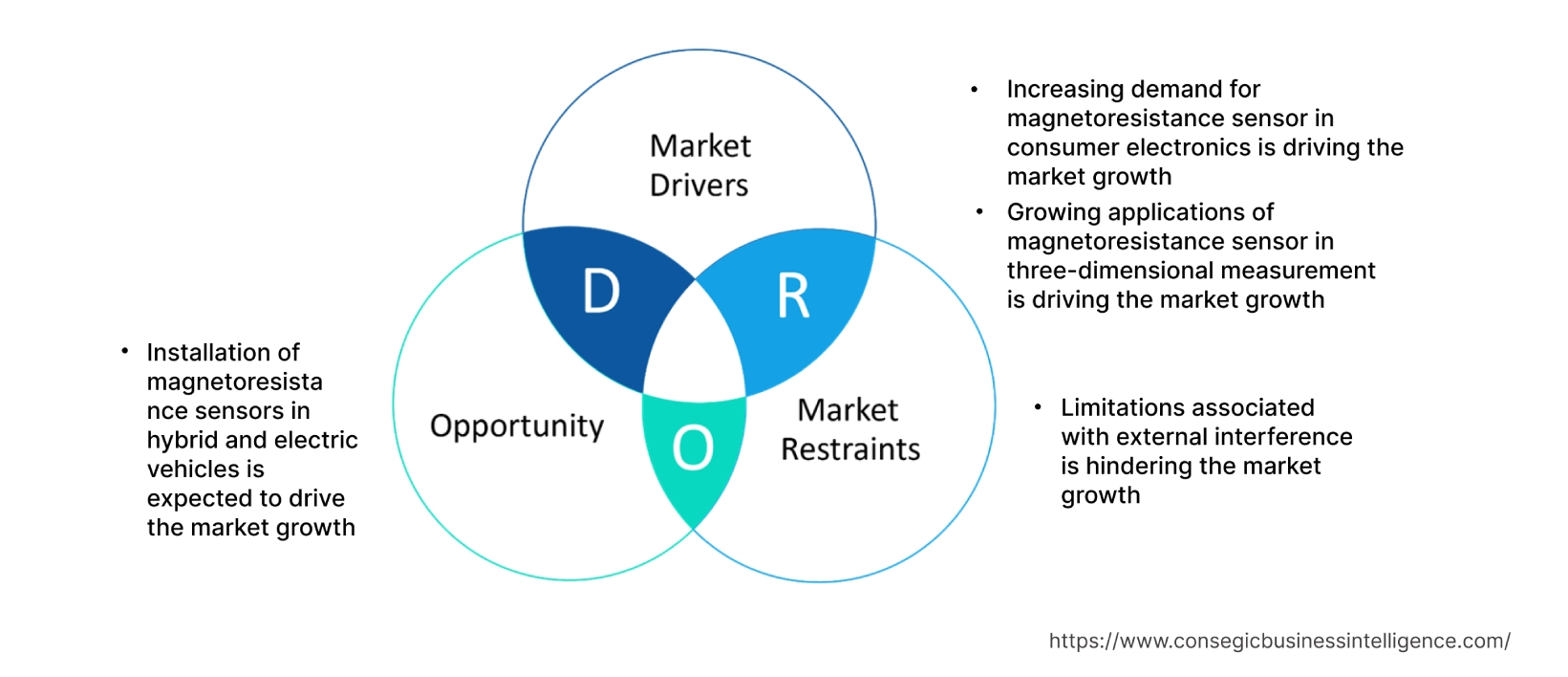Magnetoresistance Sensor Market Size :
Magnetoresistance Sensor Market is estimated to reach over USD 3,359.97 Million by 2030 from a value of USD 1,873.29 Million in 2022, growing at a CAGR of 7.90% from 2023 to 2030.
Magnetoresistance Sensor Market Scope & Overview:
Magnetoresistance Sensor is a type of sensor that utilizes the magnetoresistive effect to measure changes in electrical resistance caused by a nearby magnetic field. Moreover, magnetoresistive effect causes the electrical resistance of certain materials to vary as an applied magnetic field changes in strength or direction. Accordingly, by detecting these changes in resistance, magnetoresistance sensors accurately sense and quantify the strength, presence, and direction of magnetic fields. Furthermore, magnetoresistance sensors have wide applications including automotive systems, navigation, consumer electronics, automation, and others.
Magnetoresistance Sensor Market Insights :
Magnetoresistance Sensor Market Dynamics - (DRO) :
Key Drivers :
Increasing demand for magnetoresistance sensor in consumer electronics is driving the market growth
Magnetoresistance sensors are majorly employed to detect the magnetic field with precision. These sensors are widely used in consumer electronics applications including navigation, magnetic switches, proximity detection, among others. Devices including smartphones, tablets, gaming consoles are increasingly employing magnetoresistance sensor for accuracy and determining the proximity of an object. In addition, smartphones and tablets are utilizing magnetoresistance sensor to provide accurate direction and orientation information, thus enhancing navigation and mapping applications.
Moreover, with respect to aforementioned devices, magnetoresistance sensor is also used in cases where opening or closing of a device triggers an action. For instance, once identified if smartphone cover is closed, magnetoresistance sensor activates features that allow the device to turn off the screen or during the condition when device is held close to the face during a call.
According to OBERLO website data, smartphone users during the year was accounted for 5.01 billion and the numbers of users is estimated to reach 5.26 billion, a rise of 5% from the previous year. Therefore, with the rise in number of smartphone user tends to drive the demand for magnetoresistance sensor.
Growing applications of magnetoresistance sensor in three-dimensional measurement is driving the market growth
Magnetoresistance sensor are increasingly utilized in three-dimensional (3D) measurement applications owing to their ability to sense magnetic fields and changes in orientation accurately. Aforementioned, application include motion tracking, robotics, medical imaging, geophysical surveying, industrial automation, among others. Magnetoresistance sensor are utilized to track the movement and orientation of objects in 3D space. The application includes virtual reality, augmented reality, and motion capture being used in animation and sports analysis. In addition, in the field of robotics, magnetoresistance sensor helps robots to navigate and gather information related to orientation in complex environments.
Moreover, in aerospace and aviation sector, magnetoresistance sensor is employed to monitor the orientation and movement of aircraft components, as well as to aid in navigation and control system. In addition, in the field of medical imaging, these sensors play an important role by tracking surgical procedures, thus aiding in precise navigation and visualization during minimally invasive surgeries.
Key Restraints :
Limitations associated with external interference is hindering the market growth
Magnetoresistance sensors are limited to certain external interference factors including sensitivity, temperature dependence, non-linearity, limited detection range, drift over time, among others. Mainly magnetoresistance sensor has to deal with various external environmental conditions and need to operate under such challenges, however, few of the aforementioned conditions limit its applications and hinders the performance. External factor including influence of external magnetic field lead to inaccurate readings and require constant calibration over the shorter duration. In addition, fluctuation in temperature lead to variation in resistance and affects the sensors performance. Moreover, factors such as non-linearity generate due to uneven relationship between applied magnetic field and the change in resistance, especially at higher field strengths. Thus, owing to aforementioned hinderances being faced at different field of applications by magnetoresistance sensor is limiting the market growth.
Future Opportunities :
Installation of magnetoresistance sensors in hybrid and electric vehicles is expected to drive the market growth
Magnetoresistance sensors have wide applicability in hybrid and electric vehicles specifically for position sensing in systems including steering, electric power, throttle position sensing, and brake-by-wire systems. In addition, these sensors play an important role in motor control, battery management, and monitoring of charging processes. Furthermore, magnetoresistance sensor offers accuracy, reliability, and low power consumption facilities, thus making them valuable components in the automotive components.
Magnetoresistance Sensor Market Report Insights :
| Report Attributes | Report Details |
| Study Timeline | 2017-2030 |
| Market Size in 2030 | USD 3,359.97 Million |
| CAGR (2023-2030) | 7.90% |
| By Type | Anisotropic Magnetoresistance Sensor, Giant Magnetoresistance Sensor, and Tunnel Magnetoresistance Sensor |
| By Application | Angle & Path Measurement, Magnetic Field Measurement, Thin-Film Solar Cells, Biomolecular Detection, Three-Dimensional Measurement, and Others |
| By Region | North America, Europe, Asia-Pacific, Latin America, and Middle East & Africa |
| Key Players | Rechner Sensors, Honeywell International Inc., Infineon Technologies AG, Murata Manufacturing Co., Ltd., Asahi Kasei Micro Devices, Corporation, Analog Devices, NXP Semiconductor N.V., AMS, and TE Connectivity |
Magnetoresistance Sensor Market Segmental Analysis :
By Type :
Based on the type, the market is trifurcated into anisotropic magnetoresistance sensor, giant magnetoresistance sensor, and tunnel magnetoresistance sensor. The giant magnetoresistance sensor segment is accounted for the largest revenue share of 45.6% in the year 2022. The segment is also projected to garner fastest CAGR during the forecast period. Factor attributed towards the growth of giant magnetoresistance sensor include high sensitivity, low power consumption, liner response, high signal to noise ratio, among others. Giant magnetoresistance sensor exhibits high sensitivity to change in magnetic fields, thus allowing them to efficiently detect small variations in the magnetic flux. Moreover, these sensors consume minimal power and are more efficient and suitable for battery operated vehicles. Therefore, owing to energy efficiency, these sensors will be greatly employed in hybrid and electric vehicles in the near future that will promote market growth during the forecast period.
For instance, TLE5046iC is a giant magnetoresistance based senor introduced by Infineon Technologies, is a wheel speed based sensor designed to measure direction and movement of wheels.
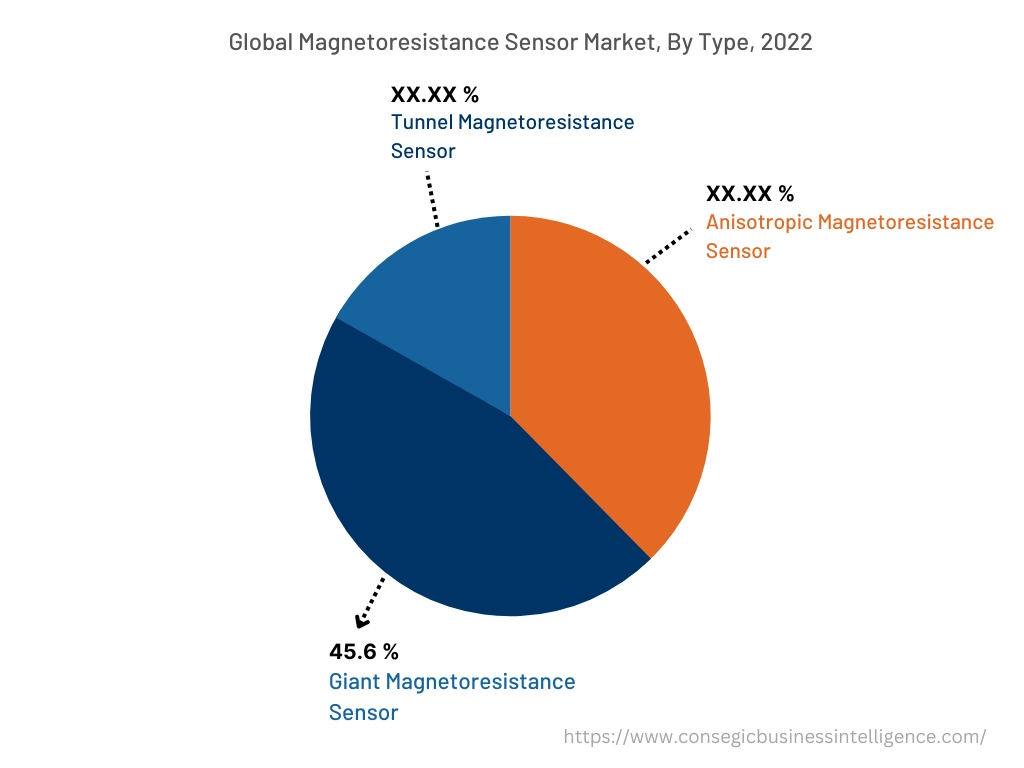
By Application :
Based on the application, the market is divided into angle & path measurement, magnetic field measurement, thin-film solar cells, biomolecular detection, three-dimensional measurement, and others.
Magnetic field measurement segment is accounted to generate largest market share in the year 2022. The key factors attributed to the growth of the segment include magnetic field mapping, non-destructive testing, magnetic particle inspection, magnetic resonance imaging, among others. The segment has wide applicability in the field of research and development, healthcare, testing, environmental monitoring, and others. Moreover, growing industrial applications and advancement in technology is boosting the demand for magnetoresistance sensors. Furthermore, applications including utilization of giant magnetoresistance sensors to create detailed map of magnetic fields of a specific area, thus helping researchers to understand the distribution and strength of magnetic fields is promoting the demand for magnetoresistance sensors.
Moreover, three-dimensional measurement segment is projected to grow at the fastest growth rate during the forecast period. Owing to rising demand for complex architectural structures and designs coupled with accurate mapping will drive the market growth of three-dimensional measurement applications in the overall magnetoresistance sensor market. Furthermore, improvement in the healthcare sector among developing countries including India, South Africa, China, Australia, among others is projected to promote the market growth of magnetoresistance sensor. For instance, giant magnetoresistance sensor is widely used in magnetic resonance imaging to sense the magnetic field gradients generated in MRI machines, which contributes to the image quality and accuracy of the diagnostic process. Thus, owing to aforementioned factors and wide applicability of magnetoresistance sensor, its demand is projected to grow during the forecast period.
By Region :
The regional segment includes North America, Europe, Asia Pacific, Middle East and Africa, and Latin America.
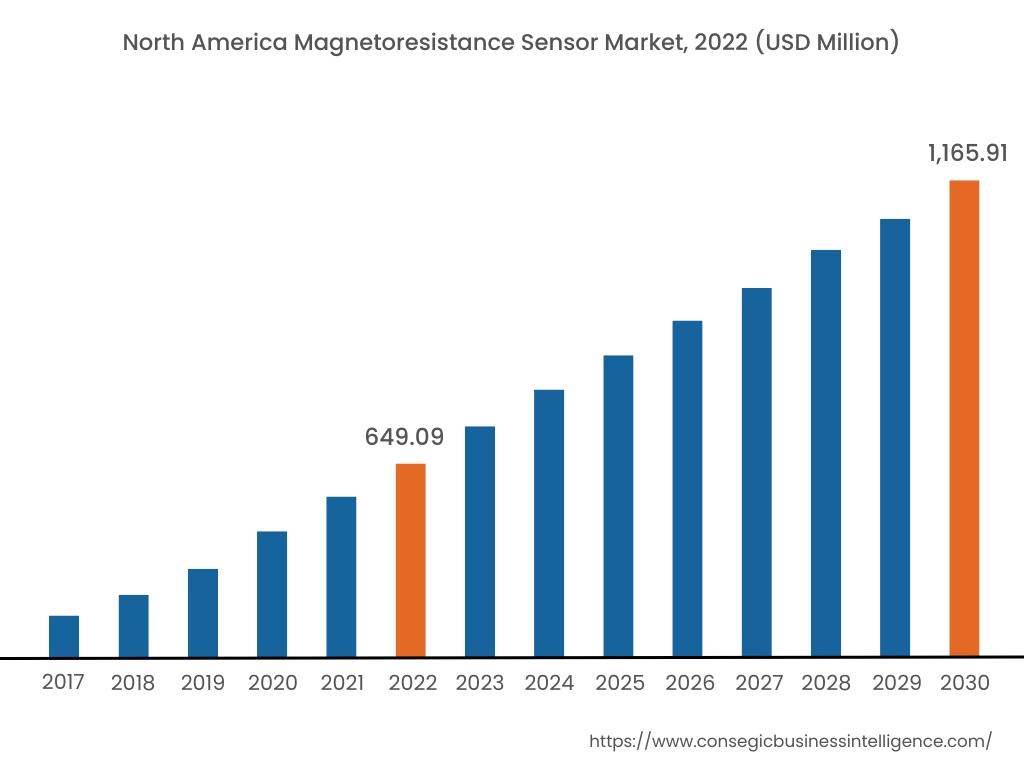
North America is accounted for the largest revenue share of USD 649.09 Million in 2022 and is expected to reach USD 1,165.91 Million by 2030. In addition, in the region, the U.S. accounted for the maximum revenue share of 55.5% in the same year. The adoption of magnetoresistance sensor in North American region is primarily driven by technological advancement in technology and innovation. In addition, the region has developed sectors including electronics, automotive, healthcare, industrial automation, among others. The region is also contributing towards development of sensor application to provide specific solutions. In addition, the rising demand for industrial automation is promoting the demand for positioning sensors for better process optimization and quality control.
Moreover, Asia-Pacific is expected to register fastest CAGR growth of 8.2% during the forecast period. The growing pace of digitalization, industrialization, growth of manufacturing sectors including automotive, industrial automations, among others are generating lucrative opportunities for market growth in the region. The region is continuing to witness rise in IoT (Internet of Things) segment, which promotes the implementation of smart devices tends to boost the growth of magnetoresistance sensor. Since IoT devices require wide range of sensors for applications including automation, data monitoring is projected to influence the demand for magnetoresistance sensor in the region. Furthermore, advent of emerging technologies including artificial intelligence, robotics, automation, and machine learning will proliferate the development of the region along with rise in demand for magnetoresistance sensor.
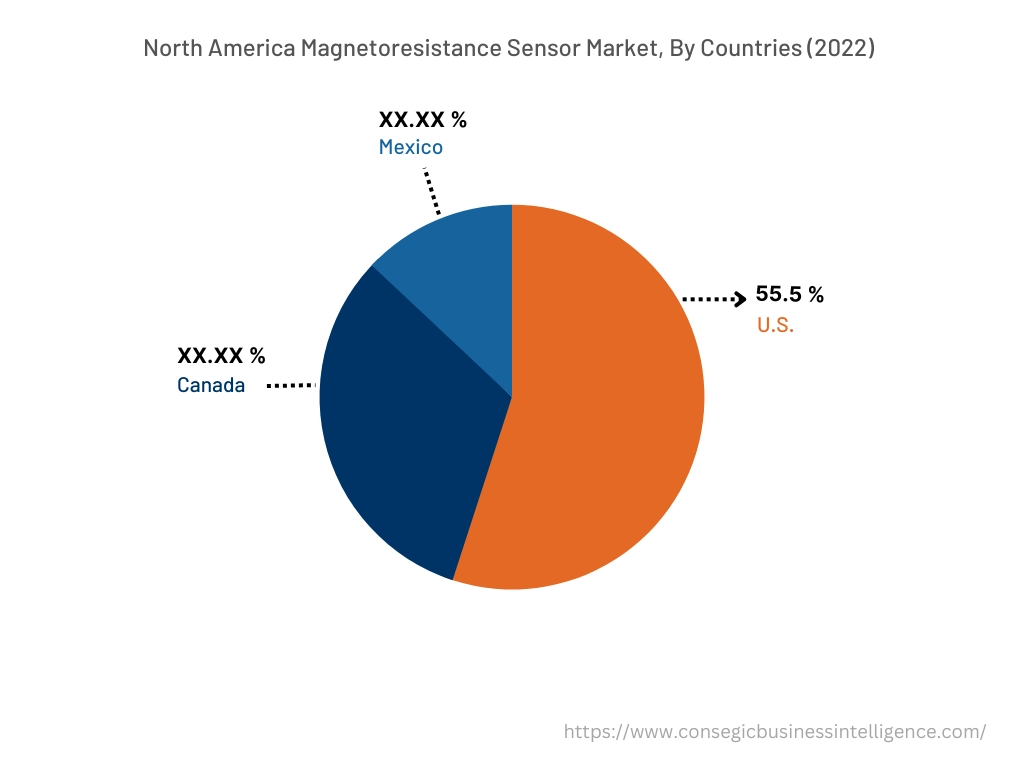
Top Key Players & Market Share Insights:
The magnetoresistance sensor market is highly competitive with major players providing Magnetoresistance Sensor to the national and international markets. Key players are adopting several strategies in research and development (R&D), product innovation, and application launches to hold a strong position in Magnetoresistance Sensor market. Key players in the Magnetoresistance Sensor market include-
- Rechner Sensors
- NXP Semiconductor N.V.
- AMS
- TE Connectivity
- Honeywell International Inc.
- Infineon Technologies AG
- Murata Manufacturing Co., Ltd.
- Asahi Kasei Micro Devices Corporation
- Analog Devices
Recent Industry Developments :
- In June 2022, Murata Manufacturing Co., Ltd. included MRMS591P and MRMS581P series of omnidirectional AMR (Anisotropic Magneto Resistance) sensors in its product line.
- In August 2023, NXP Semiconductors N.V., Robert Bosch GmbH, and Infineon Technologies AG announced to jointly invest in European Semiconductor Manufacturing Company (ESMC) GmbH, Germany to offer advanced semiconductor manufacturing services.
Key Questions Answered in the Report
What is Magnetoresistance Sensor? +
Magnetoresistance Sensor is a type of sensor that utilizes the magnetoresistive effect to measure changes in electrical resistance caused by a nearby magnetic field. Moreover, magnetoresistive effect causes the electrical resistance of certain materials to vary as an applied magnetic field changes in strength or direction.
What specific segmentation details are covered in the magnetoresistance sensor report, and how is the dominating segment impacting the market growth? +
For instance, by type segment has witnessed giant magnetoresistance sensor as the dominating segment in the year 2022, owing to its increasing demand in industries including aerospace, automotive, healthcare, and others.
What specific segmentation details are covered in the magnetoresistance sensor market report, and how is the fastest segment anticipated to impact the market growth? +
For instance, by application segment has witnessed three-dimensional measurement segment to grow at the fastest growth rate during the forecast period. Owing to rising demand for complex architectural structures and designs coupled with accurate mapping will drive the market growth.
Which region/country is anticipated to witness the highest CAGR during the forecast period, 2023-2030? +
Asia-Pacific is anticipated to register fastest CAGR growth of 8.2% during the forecast period due to rapid pace of industrialization and growth of multiple industries including consumer electronics, industrial, healthcare, and others.
